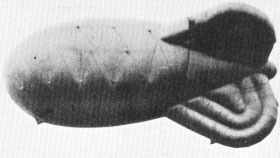 Click for Site Directory
Click for Site DirectoryThe First Fatal Casualty in Balloon Command September 2nd, 1939.
854497 Aircraftman 2nd Class, Philip Walter Hopwood
On the 25th August 1939 the Officers and men of 920 Barrage Balloon Squadron had Headquarters at Fazakerley, Liverpool and began to populate various sites in Liverpool.
“A” Flight was based at sites 7 and 18, and in charge was Pilot Officer L. B. Ridley and Flying Officer J. W. G. Purser. On 27th August 1939, “A” Flight flew their first balloon at Site 7, in King Edward Street and on 28th August 1939 flew their second balloon at Site 18, Caryl Street. This strange sight caused much excitement amongst the local inhabitants but was one they would get used to.
“B” Flight was based at sites 19, 20 and 21, and in charge was Acting Pilot Officer J. H. G. Pattinson, Acting Pilot Officer P. S. P. Morter, and Acting Pilot Officer I. A. Macaulay. On 27th August 1939, “B” Flight flew their first balloon at Site 19, in Horsfall Street and on 29th August 1939 flew their second balloon at Site 20, Dingle Lane.
On 1st September 1939, “B” Flight deployed a third crew at Site 21, St. Michael’s Street.
On the 2nd September 1939, “A” Flight deployed crews on Site 22, Jamaica Street, and Site 23, Cleveland Square. A large thunderstorm had been lashing across most of the country on 1st and 2nd of September 1939.
At 9 p.m. on 2nd September 1939 a huge thunderstorm broke over Liverpool. The crews were newly trained and the risks with lightning strikes and balloons flying on metal cables were not well understood. On Site 20, Dingle Lane, barrage balloon, LZC 1904 was struck by lightning, tragically killing 854497 Aircraftman 2nd Class, Philip Walter Hopwood, and injuring 854624 Aircraftman 2nd Class, W. Molyneux, and 854422 Aircraftman 2nd Class, T. Kirkham. The balloon fell in Beaufort Street on fire and two roofs in Beaufort Street were set alight.
Philip Walter Hopwood, age 28, was the son of Philip and Minnie Hopwood of 18 Ashley Street. Rock Ferry. He was in civilian life, a chartered accountant’s audit clerk.
At the inquest on 5th September 1939, the Liverpool City Coroner, Mr. G. C. Mort, said that: “This young man’s family can take consolation in the fact that he died in the service of his country. If this had happened few hours later, it would have been recorded as a war casualty”.
Constable A.L. Mason, said he saw a flash through the trees and saw four men stagger away. Two of them collapsed. All were taken to hospital, but Hopwood was dead on arrival. R.A.F. officers in court paid tributes to the efficiency and popularity of Hopwood, and said he died in the defence of his country just as though he had been killed on the battlefield. The Coroner recorded verdict of Accidental Death.
He was buried at Bebington Cemetery on 6th September 1939 and the Liverpool Evening Express reported:
“MILITARY HONOURS AT BEBINGTON FUNERAL Military honours were today accorded to Phillip Walter Hopwood, aged 28, a chartered accountant’s audit clerk, at his funeral at Bebington Cemetery, where a detachment of the Auxiliary Air Force formed a guard of honour. Hopwood. whose parents live in Ashley-street, Rock Ferry, was killed by lightning during a thunderstorm on Saturday. Nearly 200 people saw the departure of the cortege from Ashley-street. The coffin was draped with a Union Jack and was carried on an R.A.F. gun carriage on either side of which marched men of the bearing party. The service at the graveside was conducted by the Rev. D. L. Griffiths, R.A.F. Chaplain, assisted by other ministers. The funeral arrangements were entrusted to Messrs. Thomas Porter and Sons, Park-road, Dingle, Liverpool.
The Liverpool Echo on Tuesday 21 November 1939 ran a Notice in the paper:
“HOPWOOD— In loving 29th birthday remembrance our dear nephew, our WAL., killed while serving his country’s call, September 2, 1939.
We think you in silence.
No eye can see us weep.
But deep within our hearts
Your memory will keep
—Aunt Ruse. Uncle Albert and Ron.”
Philip Hopwood lived with his parents at 19 Ashley Street, Rock Ferry, and had one younger sister Edna May (b. 1914). Phillip was the first fatality in Balloon Command and was killed by a freak accident, which was probably made more likely due to the lack of understanding and training about the risk of lightning strikes and the risk of electrocution when tethering barrage balloons to a steel cable. Because he was killed prior to the Declaration of War, he was denied a Commonwealth War Graves Commission headstone and as a result he did not feature in the official Roll of Honour for Balloon Command. He was the first fatal casualty of over 450 men and women from Balloon Command who died either in action or on active service during the Second World War.
Peter Garwood, 18 June 2019.